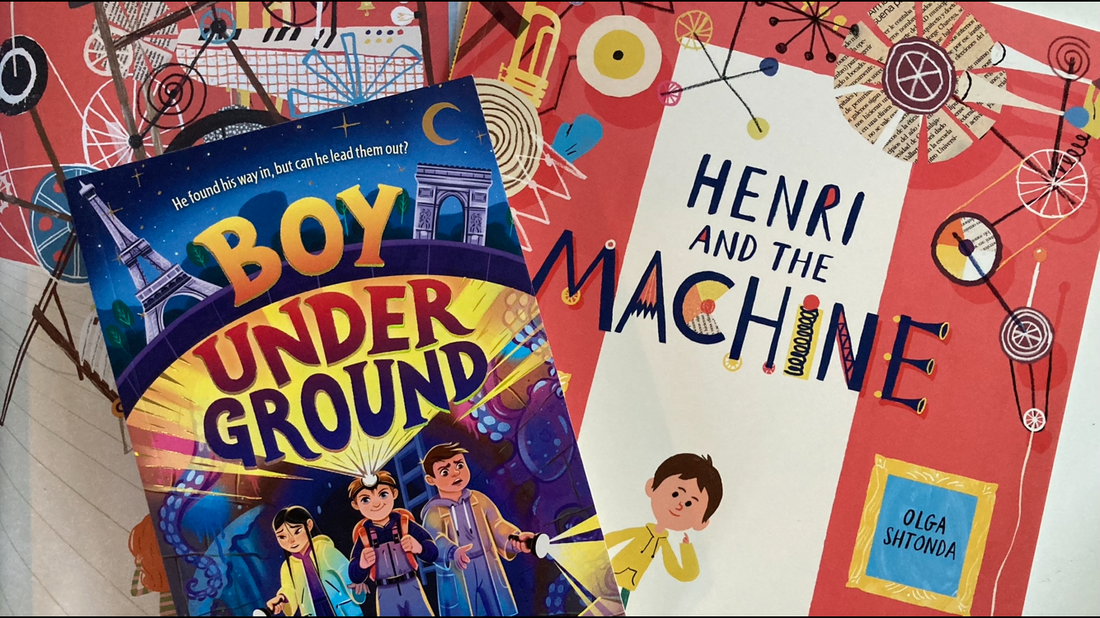Last month we were thrilled to be featuring not one but two fabulous books by Isabelle Marinov: Boy Underground in our subscription box for confident readers, and Henri And The Machine in our subscription box for mini readers. Isabelle has been crafting stories since being given a typewriter when she was 9 years old, and now she writes for both kids and adults, across genres - picture books, novels and screenplays. We are very excited to have had the opportunity to ask Isabelle a few questions; here's what she had to share with us:
In Henri And The Machine, Henri discovers that he connects with the blue picture. Do you have a favourite colour that you connect with?
My favourite colours are green and blue, the colours of the sea. My paternal grand-parents are Croatian immigrants who came from a small town on the Adriatic coast. The sea in Croatia has all those beautiful shades, from light green to deep navy blue. Just like Henri, I love the sea.
Do you have a favourite painting or sculpture?
I love the sculptures of Alexander Calder and Anish Kapoor.
What are the different challenges in writing a picture book versus a longer novel for middle grade readers?
Many people have this idea that writing picture books is easy. 32 pages…how hard can itbe? That’s exactly what makes it so difficult. Writing a good story in 1000 words or less is very tricky. You don’t have much time to develop the characters. The story has to be compelling enough for kids to want to turn the pages. The ending has to be surprising and satisfying. And the illustrations have to expand the world of the story, rather than just reflect the words. Also, if you are not an illustrator (like me, I am only a writer), you have to be careful to leave space for the illustrations. Don’t over explain. There are a lot of things that are better said through illustration than through words. In a middle grade novel, you have time to develop the characters, show them in their usual environment, before sending them off to an adventure. For me, the biggest challenge in a novel is structure and pace. It’s very hard to keep a young reader’s attention. Dialogue comes easy to me. That’s why I enjoy writing screenplays!
Paris is an exciting setting for many readers, is it your favourite city or do you prefer another destination to visit?
I love Paris; it is only a 2-hour train ride away from Luxembourg, where I live, so I can easily visit for the day. I love setting my stories in interesting destinations. My next middle-grade novel (the sequel to Boy underground) is set in Split, Croatia. I am also working on a novel for adults, set in Rome.
Which of the characters in Boy Underground do you relate to most?
There is so much of me in Hugo. I would say he is 50% my former self as a 12-year old, and 50% my son. His voice is constantly in my head. Sometimes I have to tell him to be quiet!
What is your favourite genre to read?
I love writers who can tell a compelling story in a great voice. I guess that would be literary fiction - writers such as Jean Hanff Korelitz, Meg Wolitzer and Gabrielle Zevin. But I also enjoy commercial fiction; I am a big fan of Taylor Jenkins Reid. I love graphic novels too - for kids and grown-ups! I recently read Il Deafo with my son andwe both loved it. And of course middle grade and picture books, the genres I am currently published in.
Where and when do you prefer to write?
In the morning, somewhere quiet (I always have my Bose headphones on, listening to pink noise on Spotify). I need some Japanese green tea for focus, preferably Genmaicha. Other than that, I just need absolute solitude and privacy to write, I can’t write in coffee shops or in public libraries.
Who or what is your greatest source of inspiration?
Life.
It’s clear that you love to write of course, but what are your other hobbies or
pastimes?
I love sports; I practise tennis, karate and weight training. I am currently studying for my state diploma to become a certified fitness trainer.
What was the most challenging aspect of writing Boy Underground?
I researched the Paris underground for about 6 months before writing a single line. It was important for me to get the facts right, even if I never went underground. The only part where I had to cheat a little bit was the journey they took; it was impossible for me to come up with a real-life route. There are no official maps and going underground is illegal. So I created a fictional itinerary for the three of them. I enjoyed the research part so much, I really had to force myself to stop it and start writing!
Do your character names come to you easily or is it difficult to choose them?
They usually come easily to me. Hugo (from Boy Underground) was a subconscious homage to Hugo Cabret, I guess. Leo and Henri are short names that easily translate into other languages. Interestingly enough though, Henri became Emil in the Luxembourgish edition. My publisher and I thought it sounded a bit too royal - the Grand-Duke of Luxembourg’s name is Henri.
What is the key thing you would like young readers to learn from reading Henri And The Machine?
Art is all about emotions. You don’t have to know anything about the artist, their intentions or their life. That’s all background noise. There is so much elitism and snobbery in art that I wanted to remind kids (and their parents!) that the only thing that matters is how art makes you feel!
Thank you Isabelle!

